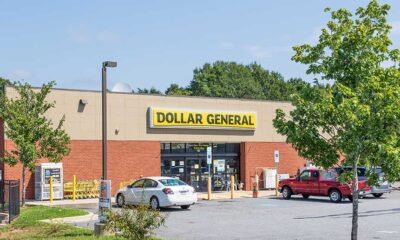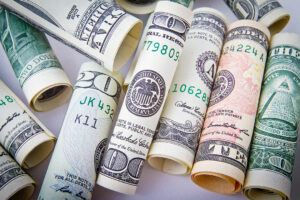Finance
Dollar General, Dollar Tree and Kroger charge cashback fees: CFPB

A Dollar General store in Germantown, New York, on November 30, 2023.
Angus Mordant/Bloomberg via Getty Images
Three of the nation’s largest retailers — Dollar General, Dollar Tree and Kroger — charge fees to customers who request “cash back” at checkout, amounting to more than $90 million a yearThis was reported by the Consumer Financial Protection Bureau.
Many retailers offer a cashback option to consumers who pay for their purchases with a debit or prepaid card.
But charging a fee for the service could “exploit” certain customers, especially those living in so-called banking deserts without easy access to a bank branch or free ATM withdrawals, according to a CFPB analysis released Tuesday.
That dynamic tends to disproportionately impact rural communities, lower earners and people of color, the CFPB said.
Not all retailers charge cashback fees, which can range from $0.50 to more than $3 per transaction, according to the agency, which has cracked down on financial institutions in recent years for charging so-called “junk fees” .
More from Personal Finance:
The IRS method as a ‘last resort’ to collect delinquent taxes
How investors can prepare for lower interest rates
Why remote work has staying power
Five of the eight companies the CFPB investigated offer free cash back.
They include Albertsons, a grocer; the drugstore chains CVS and Walgreens; and discount retailers Target and Walmart. (Kroger proposed a $25 billion merger with Albertsons in 2022, but that deal is pending in court.)
“Cashback fees are just another penny that’s all starting to add up,” said Adam Rust, director of financial services at the Consumer Federation of America, an advocacy group.
“It just makes it harder and harder to make ends meet,” he said. “It’s thousands of little cuts at the same time.”
Luis Alvarez | Digital vision | Getty Images
A Dollar General spokesperson said cash back can save customers money versus “alternative, non-retail options” such as check cashing or ATMs.
“While not a financial institution, Dollar General offers cash back options at our more than 20,000 stores nationwide as a courtesy to customers who may not have easy access to their primary financial institution,” the spokesperson said.
Spokespeople for Kroger and Dollar Tree (which operate Family Dollar and Dollar Tree stores) did not respond to requests for comment from CNBC.
Kroger, Dollar General and Dollar Tree were Nos. 4, 17 and 19, respectively largest US retailers sales by 2023, according to the National Retail Federation, a trade group.
Money back is popular
The practice of charging money back is relatively new, Rust explains.
In 2019, Kroger Co. introduced for example, a $0.50 fee for cash back of $100 or less and $3.50 for amounts between $100 and $300, according to CFPB.
This included brands such as Kroger, Fred Meyers, Ralph’s, QFC and Pick ‘N Save.
Kroger Co. However, it began charging refunds from its Harris Teeter brand in January 2024: $0.75 for amounts of $100 or less and $3 for larger amounts up to $200, CFPB said.

Cash withdrawals from retail locations are the second most popular way to access cash, accounting for 17% of transactions from 2017 to 2022, according to a CFPB analysis of the Diary and Survey of Consumer Payment Choice.
ATMs were the most popular at 61%.
But there are some important differences between retail and ATM withdrawals, according to CFPB and consumer advocates.
For example, relatively low limits on cashback amounts make it challenging to limit the impact of fees by spreading them over larger withdrawals, they said.
The average retail cash withdrawal was $34 between 2017 and 2022, while at ATMs it was $126, the CFPB said.
The banking deserts are growing
However, retailers could be the only reasonable way to get cash for consumers living in the banking desert, experts say.
More than 12 million people – about 3.8% of the US population – lived in a banking desert in 2023. according to to the Federal Reserve Bank of Philadelphia.
That figure is up from 11.5 million, or 3.5% of the population, in 2019, it showed.
In general, a banking desert is any geographic area without a local bank branch. Such people do not live within 10 miles of a physical bank branch. The rise of digital banking, accelerated by the Covid-19 pandemic, has done just that led many banks to close their physical storefronts, according to Lali Shaffer, a payments risk expert at the Federal Reserve Bank of Atlanta.
These deserts “could harm vulnerable populations” who are already less likely to have access to online and mobile banking, she says wrote recently.
Retailers blame the banks
Retail advocates say banks are responsible for the cashback costs.
Merchants must pay fees to the banks when customers use a debit or credit card for purchases. For example, these costs can amount to 2% to 4% of a transaction.
Because the cashback totals are included in the total transaction price, merchants also pay fees to the banks for any cash consumers request.
The “vast majority” of retailers don’t charge for cash back, and therefore suffer a financial loss if they offer this service for free to customers, says Doug Kantor, general counsel at the National Association of Convenience Stores and a member of the Merchant Payments. Coalition Executive Committee.
“Banks have failed a lot of these communities and they’re attacking retailers just because they’re taking people’s cards or giving people cash,” he said.
But consumer advocates say this calculation ignores the benefit retailers get by offering cash back.
‘You would think they would see this as a free way to acquire customers: come in [the] store because the bank branch isn’t there,” Rust said. “Instead, they go ahead and charge another junk fee.”













